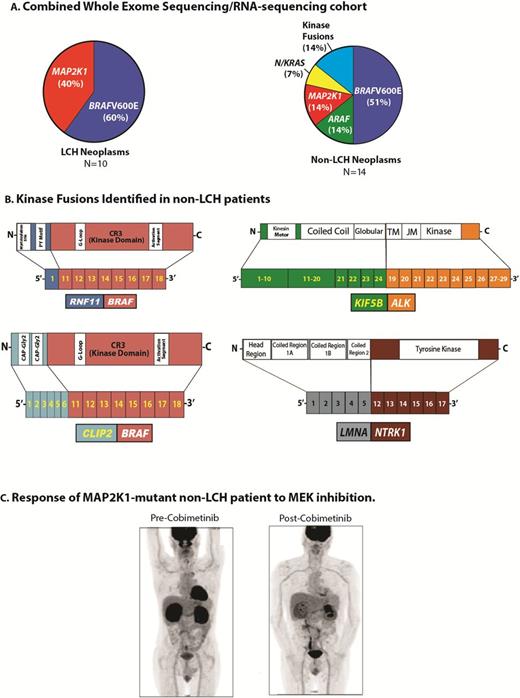Abstract
Histiocytic neoplasms are clonal, hematopoietic disorders characterized by an accumulation of abnormal monocyte-derived dendritic cells or macrophages in Langerhans Cell (LCH) and non-Langerhans (non-LCH) histiocytoses, respectively. The discovery of the BRAF V600E mutation in ~50% of patients with LCH and the non-LCH Erdheim-Chester Disease (ECD) provided the first molecular target in these patients and novel insights into the pathogenesis of these disorders. However, recurrent mutations in the majority of the ~50% of BRAF V600E-wild type patients with non-LCH are unknown. Moreover, recurrent mutations outside of the MAP kinase pathway are undefined throughout histiocytic neoplasms.
To address these issues, we performed whole exome sequencing (WES) of frozen biopsies from 24 patients with LCH (n=10) or ECD (n=14) paired with peripheral blood mononuclear cells. 13/24 patients also underwent RNA sequencing (RNA-seq). All mutations in activating kinases were validated by droplet-digital PCR, while targeted-capture next-generation sequencing validated all others. Both adult (n=18; n=2 with LCH) and pediatric cases (n=9; n=8 with LCH) were included.
Using combined WES/RNA-seq, activating kinase alterations were identified in 100% of patients. In LCH, 60% and 40% had BRAF V600E and MAP2K1 mutations, respectively. In non-LCH 51%, 14%, 14%, and 7% were BRAFV600E, ARAF, MAP2K1, and NRAS mutant (Fig1A). Overall, a mean of 7 non-synonymous mutations per adult patient was identified (range 1-22) compared with 5 mutations per pediatric patient (range 4-9; p =ns). Mutations affecting diverse cellular processes were found to co-exist with kinase mutations including mutations in epigenetic modifiers and the p38/MAPK pathway.
In addition to kinase point mutations, RNA-seq identified recurrent, in-frame kinase fusions-a first for these disorders. All identified fusions were validated using FISH and RT-PCR. This includes novel fusions in BRAF (RNF11-BRAF and CLIP2-BRAF), as well as therapeutically important fusions in ALK (2 separate KIF5B-ALK fusions) and NTRK1 (LMNA-NTRK1;Fig1B). Expression of each fusion in Ba/F3 cells conferred cytokine-independent growth. Importantly, the BRAF fusions were found to be sensitive to MEK inhibition but resistant to vemurafenib while the ALK fusions conferred sensitivity to the ALK inhibitors crizotinib or alectinib.
We next interrogated a validation cohort of 37 BRAF V600E-wild type, non-LCH, formalin-fixed, paraffin-embedded tissue samples using targeted mutational profiling for MAP2K1, ARAF, NRAS, KRAS, and PIK3CA. This revealed activating mutations in MAP2K1 (32%; n=12), NRAS (16%; n=6), KRAS (11%; n=4), PIK3CA (8%; n=3), and ARAF (3%; n=1).
Three of the investigated non-LCH patients with refractory disease and progressive organ dysfunction were treated with targeted therapies based on the discovery of novel kinase alterations described above. Treatment of 2 refractory MAP2K1- mutant, non-LCH patients with MEK inhibitors (trametinib or cobimetinib) resulted in dramatic clinical improvement (Fig1C). Both patients have been maintained on MEK inhibitor single-agent therapy with a sustained clinical response for >100 days. Further evidence of effective targeted inhibition was found in a refractory ECD patient carrying an ARAF S214A mutation. This patient failed to respond to 3 lines of prior therapies and suffered near blindness due to disease infiltration in the retina and optic nerves. Given a recent report of complete response to sorafenib in a lung cancer patient with an ARAF S214C mutation, we initiated sorafenib. Within 12 weeks, there was improvement in the patientÕs eyesight and decreased infiltrative disease, coinciding with >50% decrease in mutant ARAF DNA in plasma cell-free DNA.
Whole exome and transcriptome sequencing identified activating kinase mutations or translocations in all patients with the common downstream effect of activating the MAPK pathway. The preliminary, dramatic, clinical efficacy observed with use of MEK and RAF inhibitors in MAP2K1 - and ARAF-mutated, non-LCH patients further supports the central role of targeting the MAPK pathway in these tumors. The discovery of the discussed mutations and fusions in diverse kinases provides critical new insights into the genetic events central to a spectrum of adult and pediatric histiocytic neoplasms.
Off Label Use: This abstract describes use of MEK inhibitors (both tremetinib and cobimetinib) as well as sorafenib for MEK1 and ARAF mutant histiocytosis. . Stephens:Foundation Medicine, Inc.: Employment, Equity Ownership. Miller:Foundation Medicine, Inc.: Employment, Equity Ownership. Ross:Foundation Medicine Inc.: Employment. Ali:Foundation Medicine Inc.: Employment. Hyman:Chugai Pharma: Consultancy; Biotherapeutics: Consultancy; Atara: Consultancy, Honoraria.
Author notes
Asterisk with author names denotes non-ASH members.


This feature is available to Subscribers Only
Sign In or Create an Account Close Modal